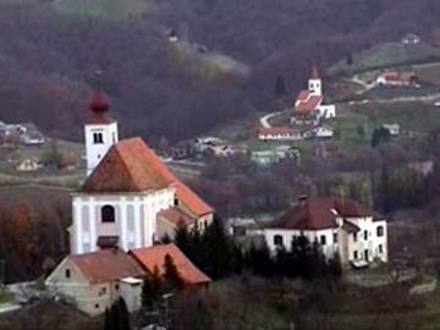SloveniaHolidays.com > Activities > Gorca
Gorca

Starting point: Podlehnik
- Path length :
30.0 km - Time:
00:00:00 - Difficulty:
Medium - Ground:
Asphalt, Macadam
Description of path
This route begins by the restaurant Pri ribniku in Podlehnik, where you should turn right at the first crossroads and carefully cross the Maribor - Gruškovje highway. Continue along the main road past the Podlehnik model and the church of Mary (from the late gothic period) toward Kozminci. After seven kilometers, you should reach a sign welcoming you to Žetale. From there, it is only a short, light ascent to the town of Žetale. By the communal building, turn right toward Majšperk or Nadole. You will now face the first major ascent of the route, as you will go from 315 to 413 meters above sea level. At the top of the hill, you will have a beautiful view of the valley, the Maclja mountains and the »Triglav of Haloze« - Donačka gora. Once you have finished admiring all of these things, descend to Marija vas, where you should take the side road right toward Pšetna graba and onward to the Peklače valley. After you turn onto the side road, you will need to cycle up a slope, then go down a macadamized road. This road continues for about three kilometers before being replaced by asphalt in the village of Peklača. Proceed down the asphalt road, preparing for the final part of the route, which begins at the side road leading south to Rodni vrh. If you are at least moderately fit, you should have little trouble overcoming this last ascent (about a kilometer and a half in length, going from 268 to 366 meters above sea level). Now, you may think the worst is behind you... But in front of you is a kilometer of macadamized road as well as a hill that you will need to ascend. At the top, those of you with an interest in culture may visit the church of the Holy Spirit and the old school, built in 1890. Then, continue along the most beautiful part of this route, between the hills of Haloze. Finally, descend past the abandoned Gorca inn and the church of the Holy Trinity back to the restaurant Pri ribniku.
The church of St. Mary in Zakel, built in 1773, is a fine example of baroque architecture. The church of St. Mary the Consoler in Brezje pri Žetalah was built between 1716 and 1723, probably under the supervision of J. Fuchs. The impressive baroque building has impressive baroque furnishings: six side altars, the main altar (carved at the end of the 17th century), and the famous organ, created by the organist Frančišek Janeček of Celje in 1763. The church of St. Michael in Žetale combines the gothic style of the 15th century and the baroque style of the 18th century. The presbytery is covered by a cross-ribbed arch, and on the right side of the nave you can still see traces of frescos from the late gothic period of the 15th century. The succursal church of the Holy Spirit on Rodni Vrh was built in 1662 on the site of an older building from the 15th century. Nothing but a cross-arched presbytery is left of that building. The church of the Holy Trinity on Gorca was built in 1654 by the Dominicans. In 1754, a Dominican monastery was built next to it. The Minorites (who succeeded the Dominicans) moved the seat of the parish from Podlehnik to Gorca in 1828. The mighty baroque building has a baroque altar dedicated to the Holy Trinity, side altars to St. Anne and St. Florian as well as other attractions such as the ceiling murals (from 1900) and the Stations of the Cross.
Warning
The author of these pages takes no responsibility for the described cycle routes or for the accuracy of the data. We have presented the cycle routes to the best of our ability, but the cyclist and the maintainer of the route are ultimately responsible for the safety of the trip.









